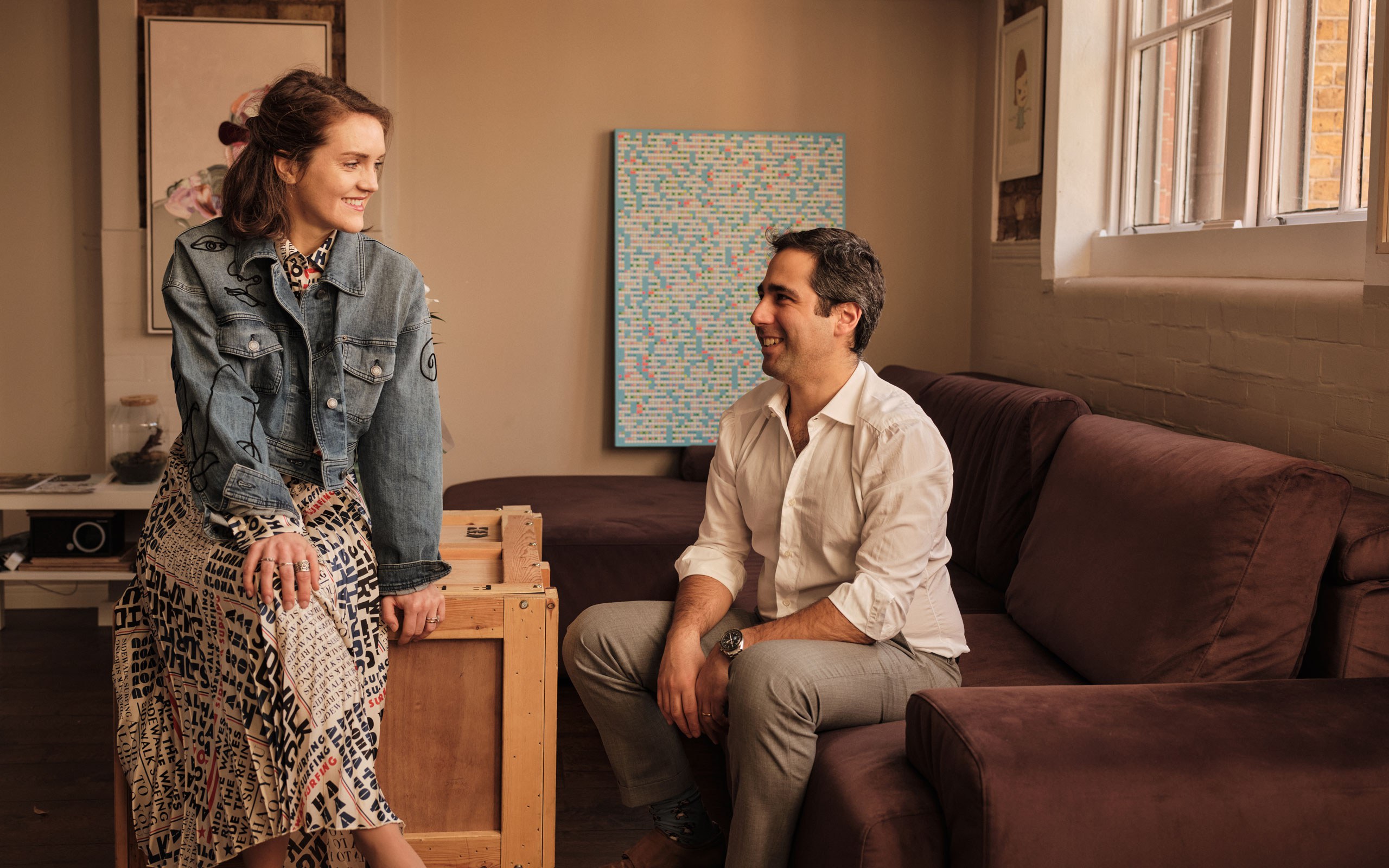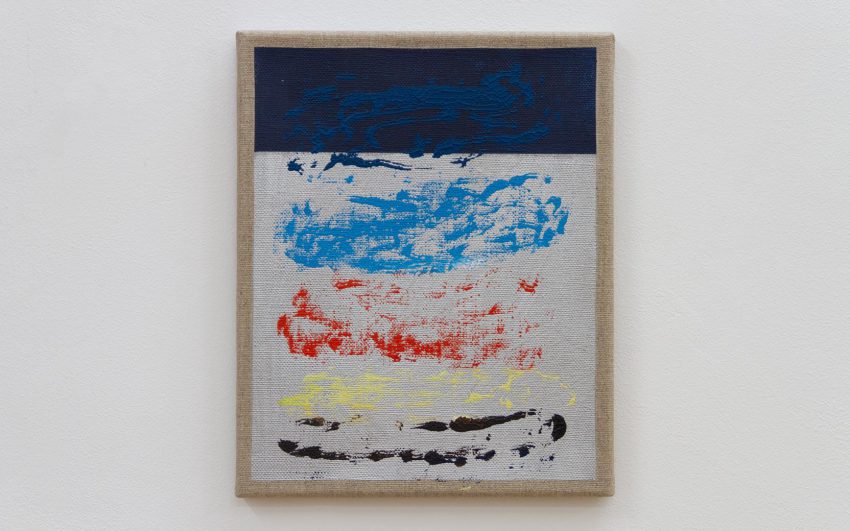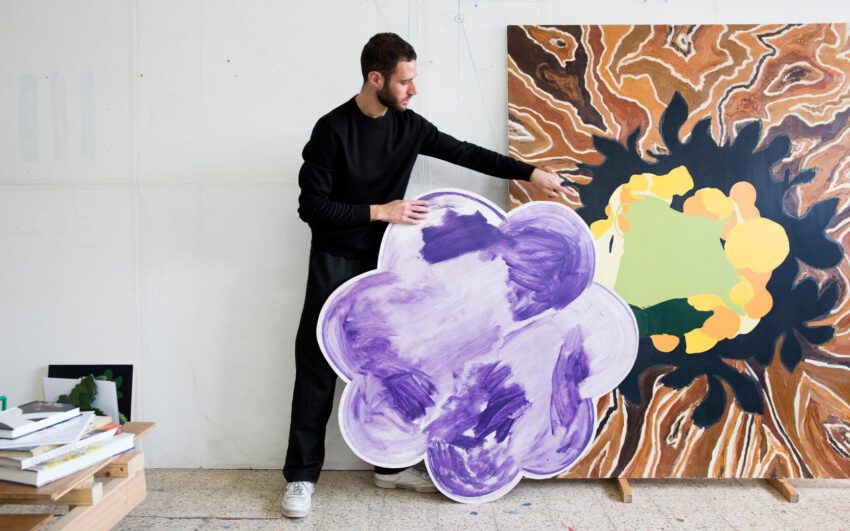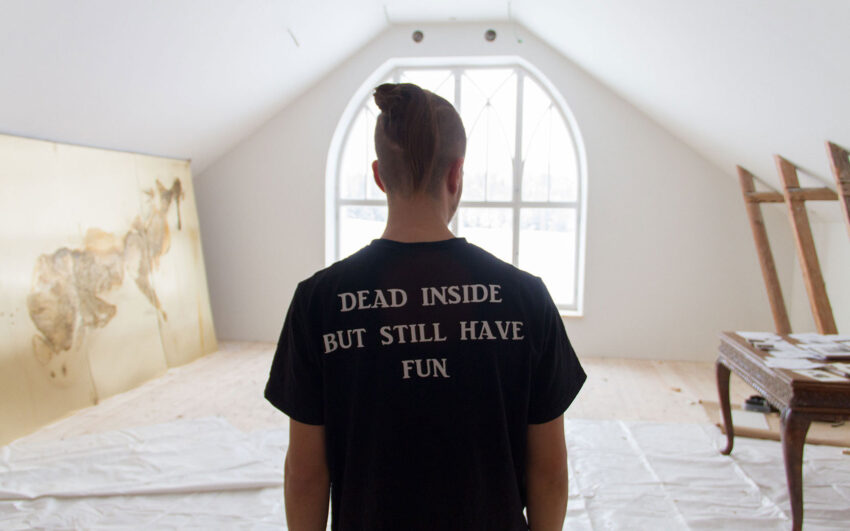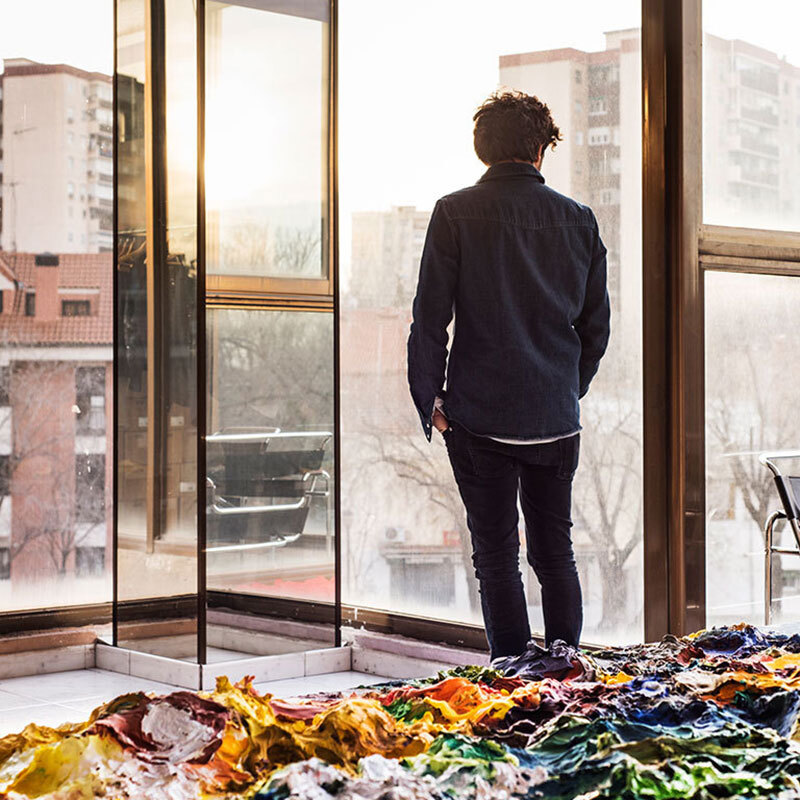This collector story is in collaboration with Artscapy. Their Art Account provides 5,000 collectors with a complete set of services from collection management to valuations, insurance and advisory.

A former London school building may not be the first place that comes to mind when you think of contemporary art, but Alessandro and Emilia De Stasio saw the potential in their Hackney flat’s large windows and mismatched features and have turned it into a space for just that. Co-founders of the ‘next-gen’ online-collectors platform Artscapy, the couple lives, works and enjoys collecting art together, a shared passion to which their home is a testament.
Emilia, Alessandro, so, how did you first begin collecting art together and who was the first artist you bought?
Alessandro (A): We met in 2015. While living in the UK, I had become interested in the street art scene, Banksy in particular. We both loved the way he used wit and satire to reflect a certain point in history. I had bought a few pieces and then we started looking together to build a collection. We bought 15 or 16 pieces in quick succession. The Banksy market back then wasn’t what it is today. Even now, a big part of our collection is social critique. It’s not necessarily about an artist having a political agenda, but about social observation.
Emilia (E): As we started to collect the more it became an intellectual hobby and we started to challenge ourselves and develop an eye for what we liked and what we wanted to say with our collection. So, we have three strands. There’re the socio-political, which Banksy fits into. Then there’s the environmental, so art which deals with nature or the destruction of it. And then finally, the creation of self. How identity is formed and the challenges we face that define who we are, and how we understand ourselves. Aside from those three themes, there is also a rule we stick to which is that we only collect living artists.
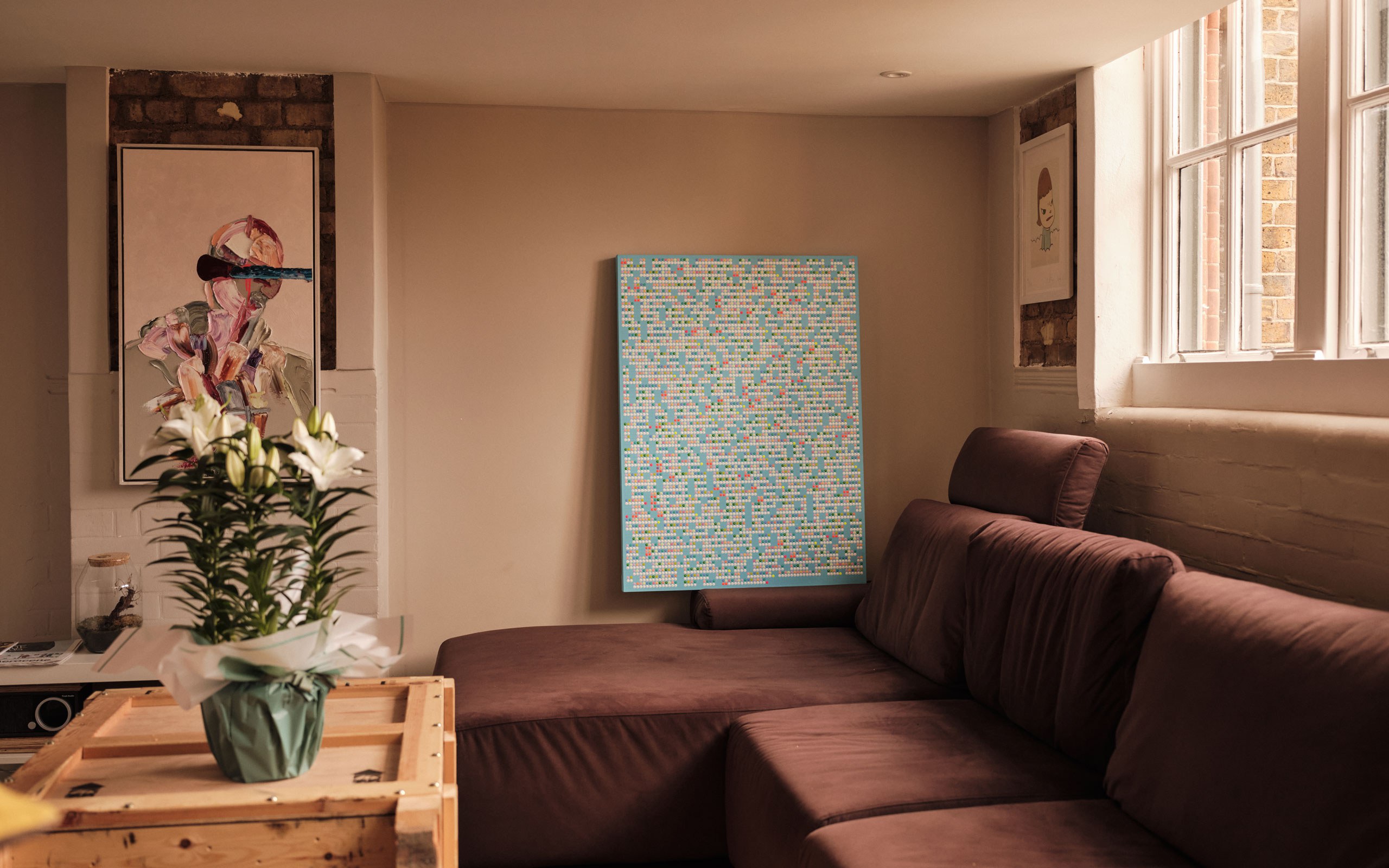
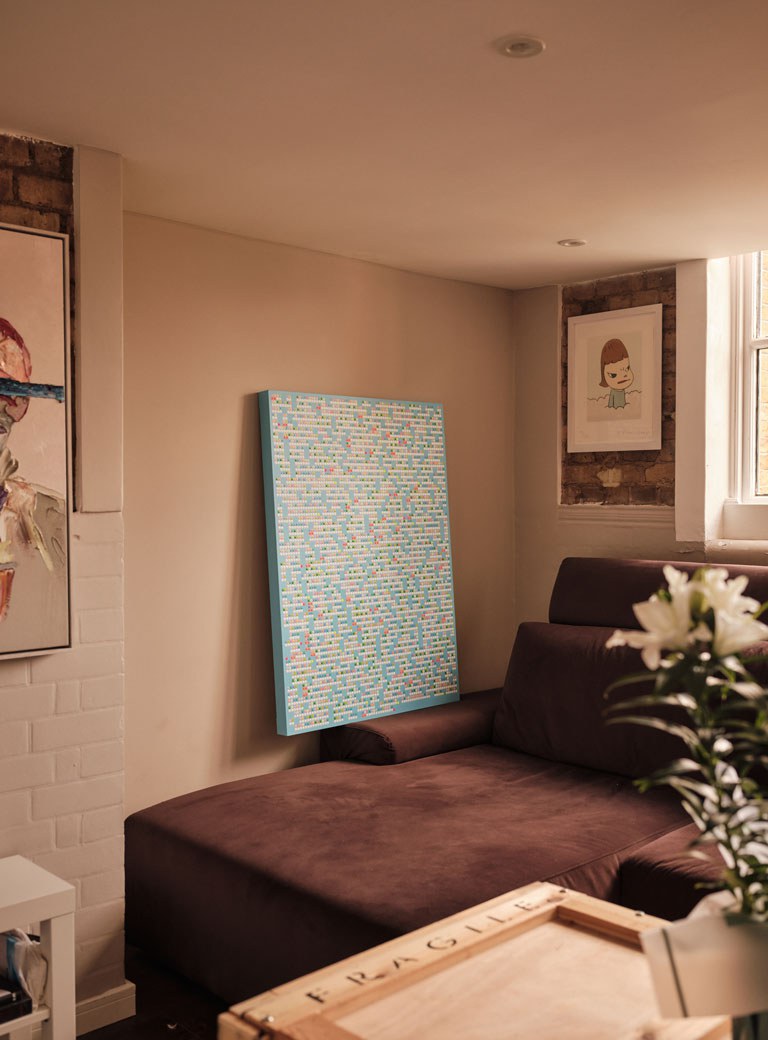
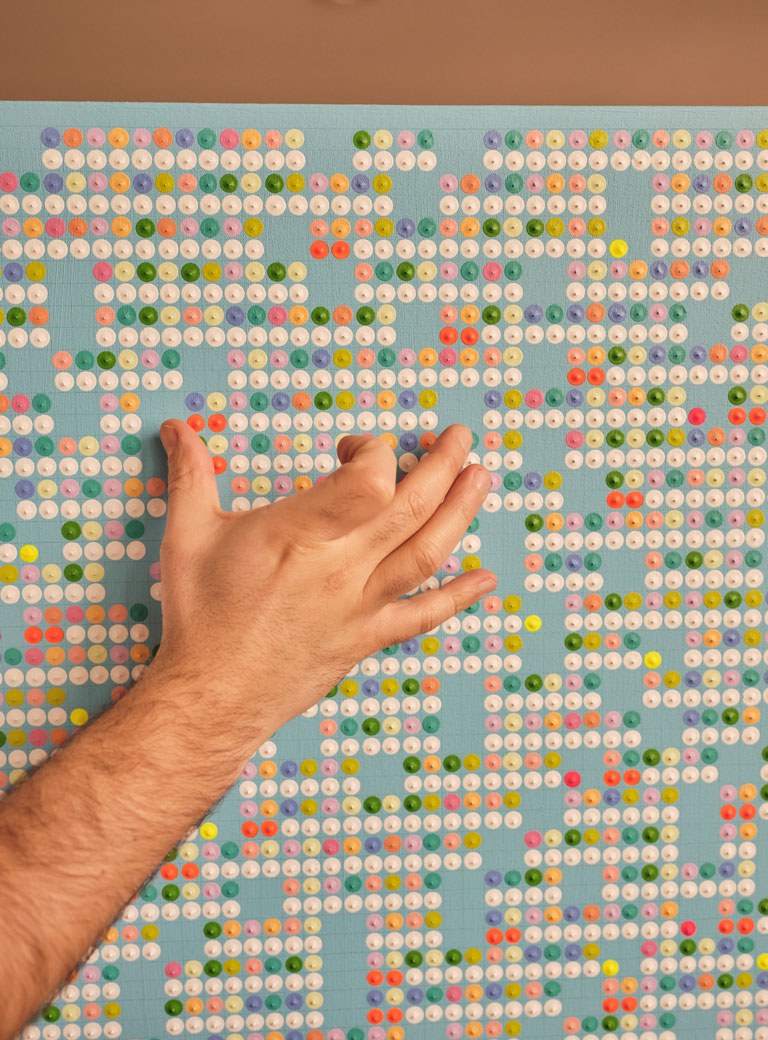
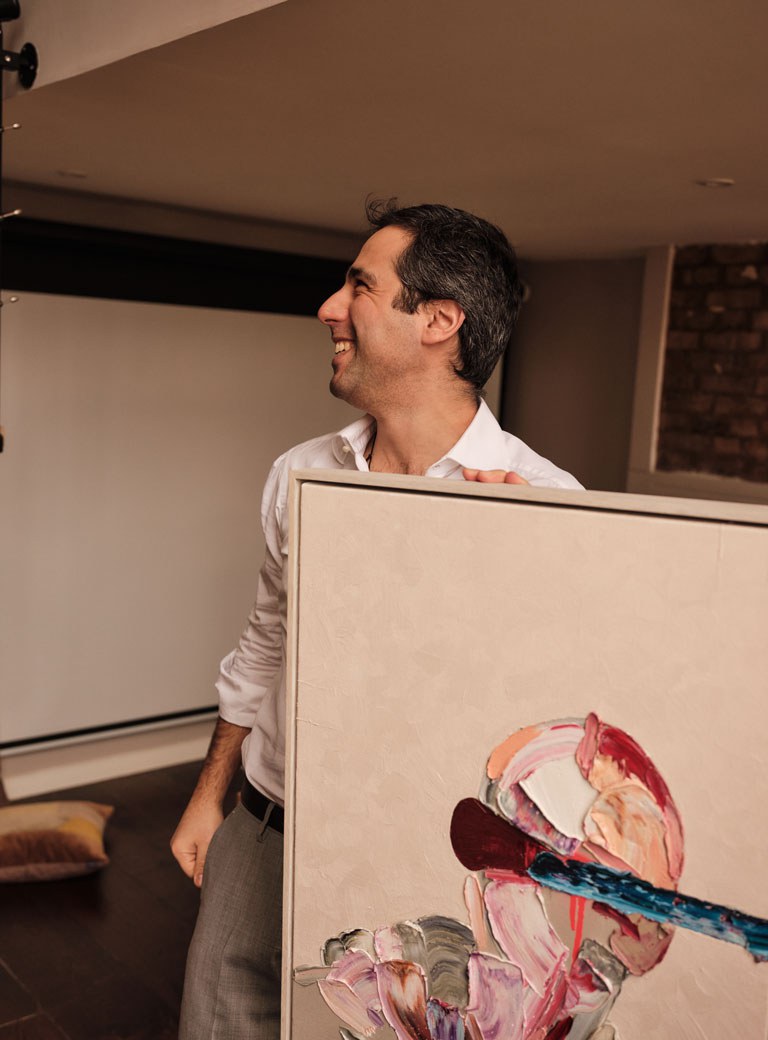
Some might say that’s a bold decision, why did you make that a rule?
E: We wanted to create a collection that reflects our time and our story. And as much as we admire Basquiat or Haring, we didn’t personally live through that time in New York in the 70s and 80s.
A: We enjoy the intellectual challenge of having a structure to the collection and having a narrative running through it.
E: It feels important to tell the story of the time we are living in because for me I think that art is the foremost reflection of the time that we live in and that artists are the most acute social scientists out there, they see, and they can predict and feel times at a much deeper level than the rest of us do. I find the ability to capture that in artworks fascinating.
A: And for me, art is the vehicle that foresees what is happening today before anyone else does. It is the mirror that tells you what is going to happen in 10, 15, 50 years – that is the power of art in my opinion. The challenge of conceptual art, especially, is not to provide a set answer. But to pose a question that triggers an interpretation that develops over time. That’s why futurism was so interesting, why the avant-garde has been so interesting and why Duchamp was so disruptive. Artists can make a point about society that has previously been unseen. I think that’s something the works we are drawn to capture.
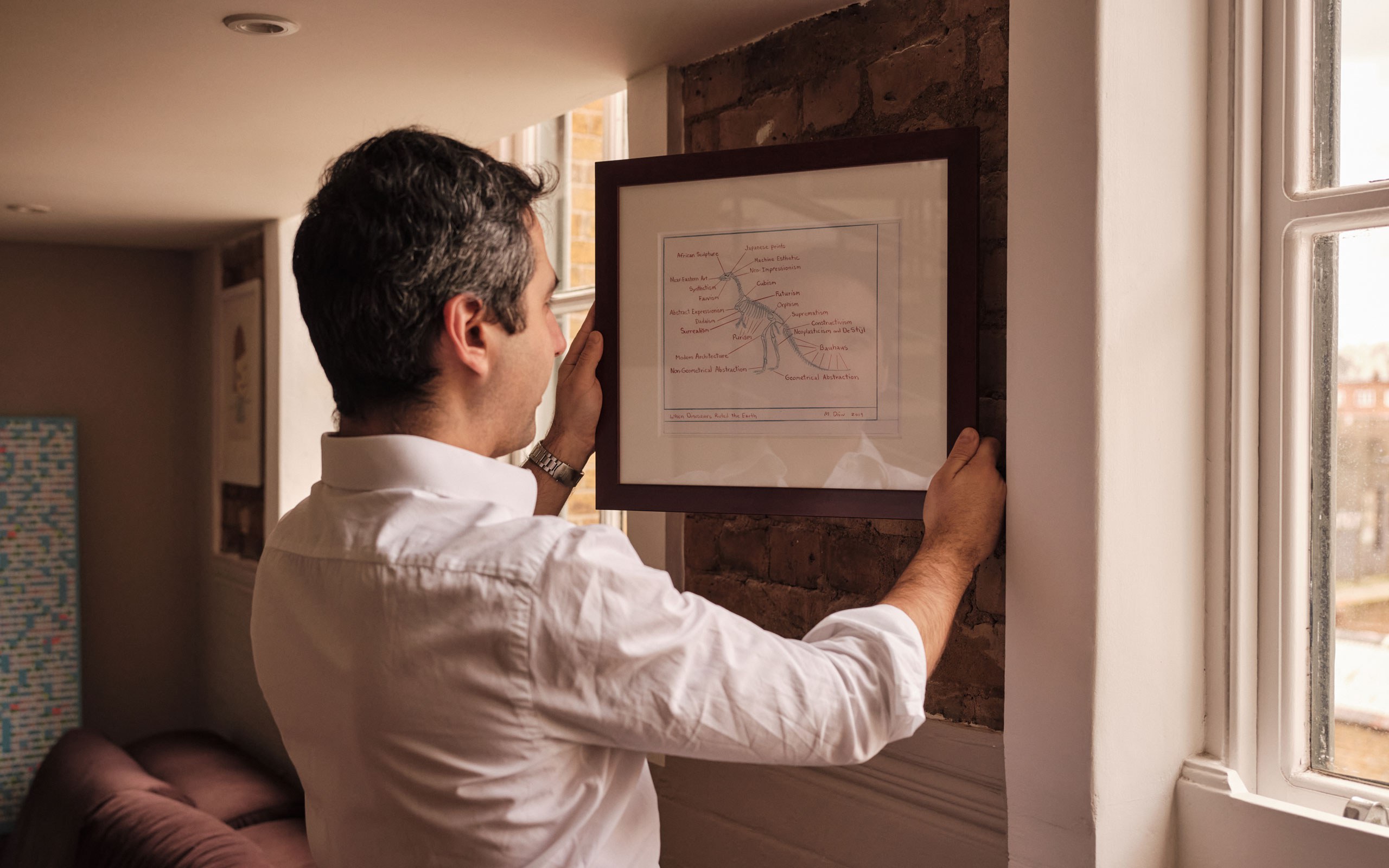
So, were an alien to visit your home, what do you think they would make of the art?
E: Maybe they would think they were looking in the mirror? [Emilia jokes and gestures towards a large painting depicting two androgynous humanoid creatures behind her – Zwei Körper mit Gurt und weisse Punkte by Andriu Deplazes]
E: I think the key themes on display in this work are concerns about the environment, the direction in which we are headed, and the destruction of nature.
[Emilia points to another piece, a sculpture by Michael E. Smith that consists of a metal anvil gripping two pieces of shell and resting on top of a wooden palette]
E: And here, Michael E. Smith captures what’s been left by humans and what’s been left by nature and how they interact and how we also let our world and nature go. So, I think looking at our collection, you see a lot of these tensions and struggles.
A: I agree, I think our collection captures a sense of the tension of things being in the process of becoming something else. It’s up to the viewer to decide whether they are moving towards the positive or negative – you may have a different take on what things can become.
[He points to a tapestry-like piece hanging on the wall, made of brightly coloured fabric.]
A: This artist is Samuel Nnorom, the artist creates intricate maps of fabric-covered foam balls stitched together, evoking a metaphor for a ‘fabric of society’. Each bubble is its own closed social structure. Using Ankara fabric – whose origins are complex in the history of the African continent, Nnorom explores its protean symbolism and reappropriates a contemporary fabric omnipresent in his community. The map can be read also as a commentary of the African diaspora, and the exploitation of the continent by other countries. The Ankara fabric was introduced to West Africa by Dutch merchants in the 1800s and has a complex history and origin. Today this fabric is still printed abroad, then shipped to China for chemical fixing and finally arrives in Africa where it will become part of the local fashion production. This work is fundamentally a sociopolitical work with strong historical undertones.
[Alessandro gestures towards a Michael E. Smith sculpture made from the bodies of several desiccated pufferfish attached to a see-through PlayStation controller which contains blue liquid as if it were a toy aquarium.]
A: And in the same way, you could say the work of Michael E. Smith captures that sense of an evolving dialogue with the way that he captures the symbiotic tension between nature and humankind.
Does having such a strong narrative in mind ever stop you from buying pieces for the sake of pleasure?
A: Absolutely not, they wouldn’t be in our home if we didn’t derive pleasure, love and enigma from them.
E: The most difficult times for us have been when we are moving house, and we haven’t been able to have the art up to look at every day. I thought I would miss it, but I didn’t expect it to affect me as much as it did. The deep longing, I felt for it was spectacular. I can live without a lot of things, but I can’t live without the art. It helps me reflect and informs my mood every day.
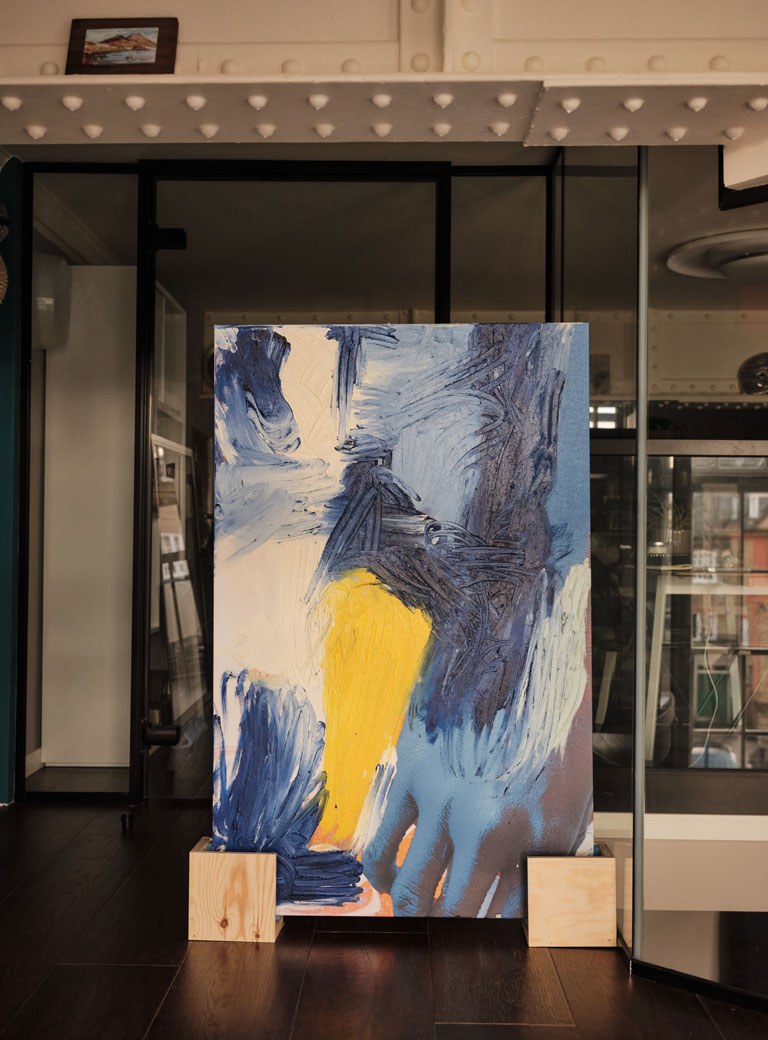
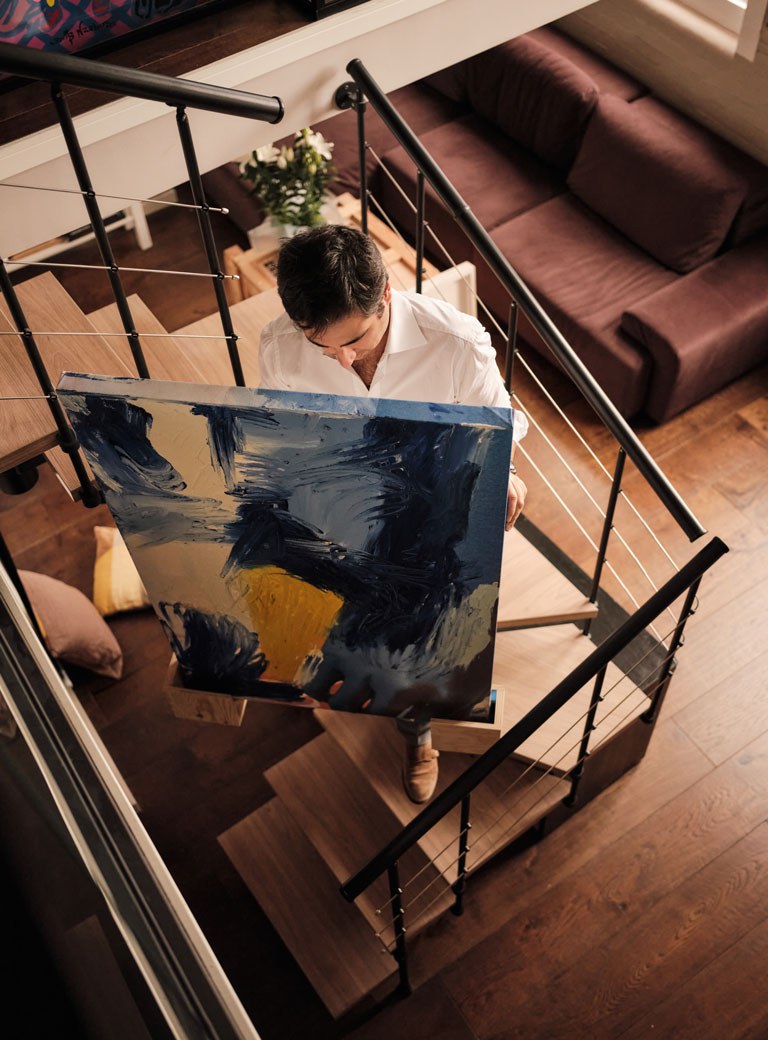
How do you decide where to put new pieces?
A: It’s a logistical challenge.
E: Which is exacerbated by our increasing infatuation with big works. But Alessandro and I are both quite analytical, so we discuss when we buy new works and there’s a narrative that links works in different areas of our home. We once even made a to-scale PowerPoint mock-up of our place and then downloaded images of the works from our Artscapy account, where we had our collection, to see how they would fit before hanging them in real life.
God forbid it were ever to happen, but which pieces would you save from a fire, and why?
[Emilia points to Zwei Körper mit Gurt und weisse Punkte, 2019 by Andriu Deplazes]
E: This is one of my absolute favourite pieces – it’s fantastic. Apart from the craftsmanship and art historical references it tells so many stories. It’s about human relationships and world connection and conveys an environmental message too, the sense that we are all stuck in one place together, somehow.
A: I would pick the Michael E. Smith sculptures because, for me, he is an artist who creates an incredible synthesis that shows the effect of humans on the broader world and nature. His work speaks to the failure of humanity and the far-reaching impact of the Industrial Revolution, socially and ecologically. It’s a period that is rarely spoken about in a real way because we are usually inclined to celebrate the economic impact of it. But he addresses much more than that.
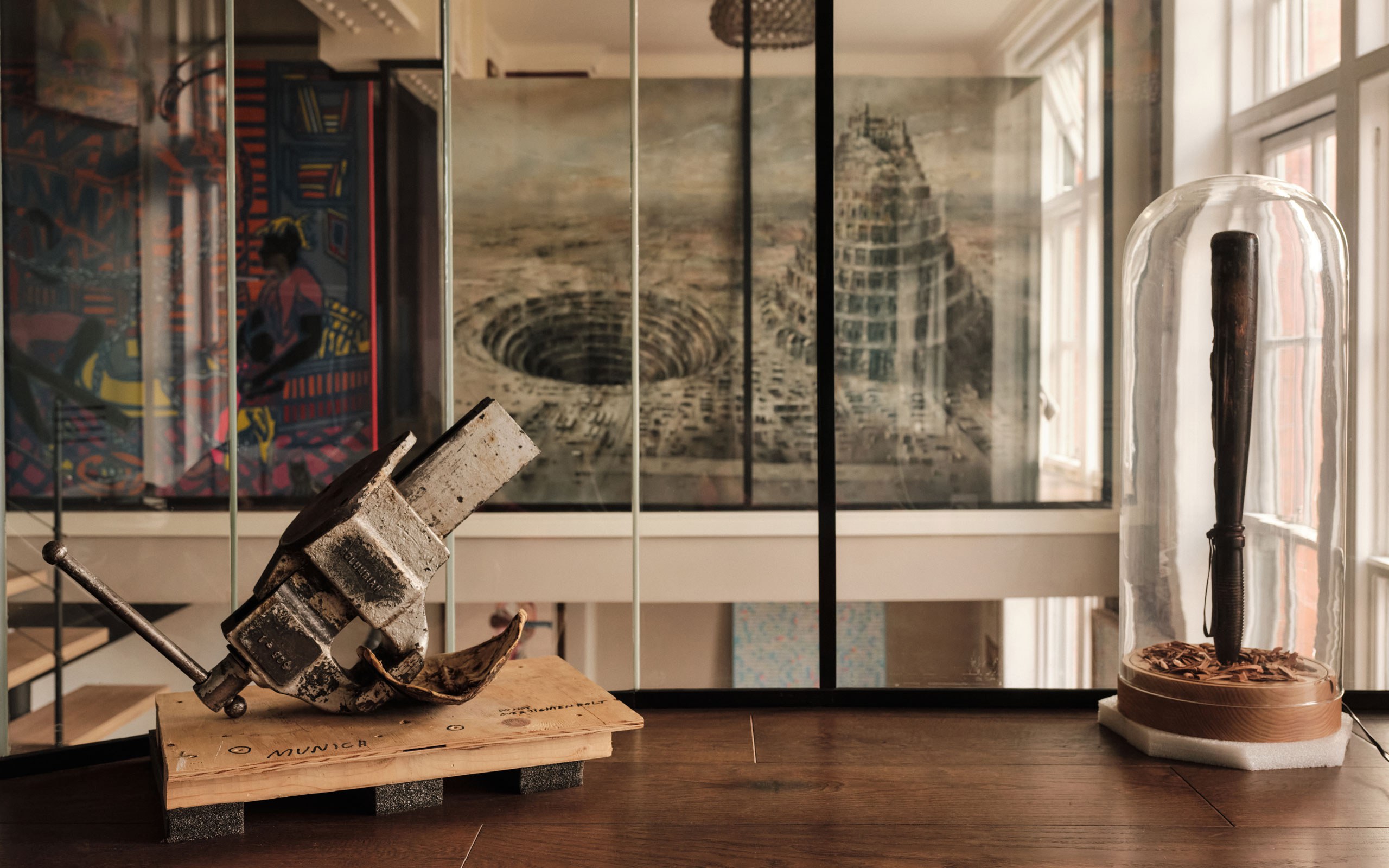
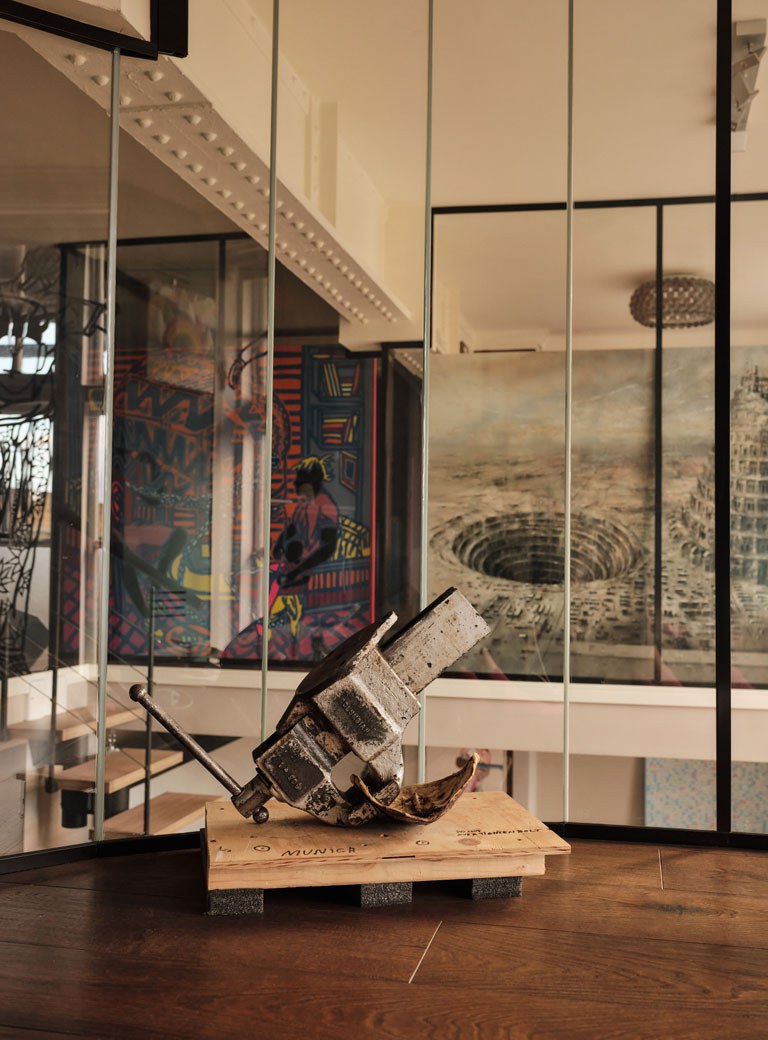
While you seem to enjoy works that hold a mirror up to the challenges faced by society today does art give you hope for the future too?
E: Certainly, absolutely.
A: I think that every artwork can be seen both ways. It’s funny because while our taste may seem to be on the gloomier side, I think every artwork is full of interpretations. So, the fact that there is a critique, doesn’t mean that it’s binary positive or negative in meaning. It is almost factual, so it shows you what it is. And makes you question how you feel about it.
E: For me, one of the funniest instances of this was when we got a Banksy print of the Grim Reaper. So, the Reaper is sitting on top of a clock face that resembles that of Big Ben with a big smiley face, and at first look, I thought that it was kind of depressing, it certainly had a down mood and it makes you think of death and of all these morbid things. But, once we had it home, the more I started to look at it and the more I thought of it as having a fundamentally optimistic message. To me, it’s in some ways a reminder that you only live once so take care of the time you have because you only have this opportunity or lifetime to live and to create something so take advantage of the day.
Given that you are quite methodical about the type of art you collect, does the same apply to how and where you find and buy it?
A: We don’t have a golden rule, but we try to buy primary work from galleries where possible because supporting emerging artists is key to our journey and that is why we keep collecting and buying.
E: We don’t go to auctions as much anymore but we did more at the beginning, especially if there was a particular work we were really excited about.
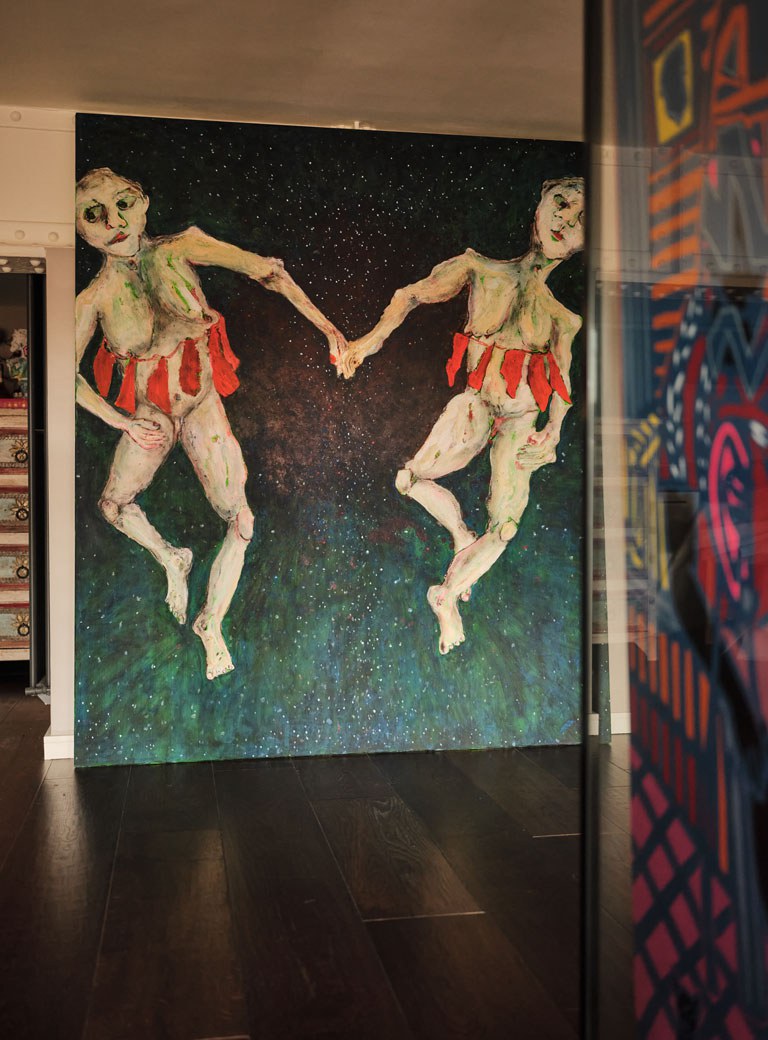
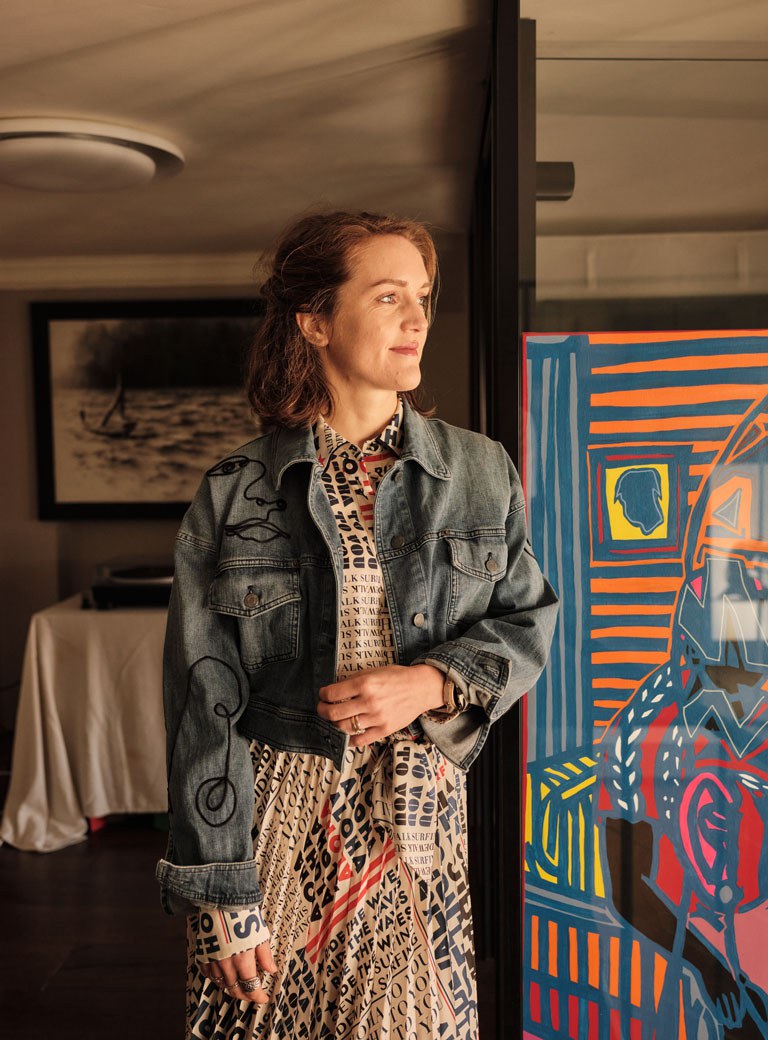
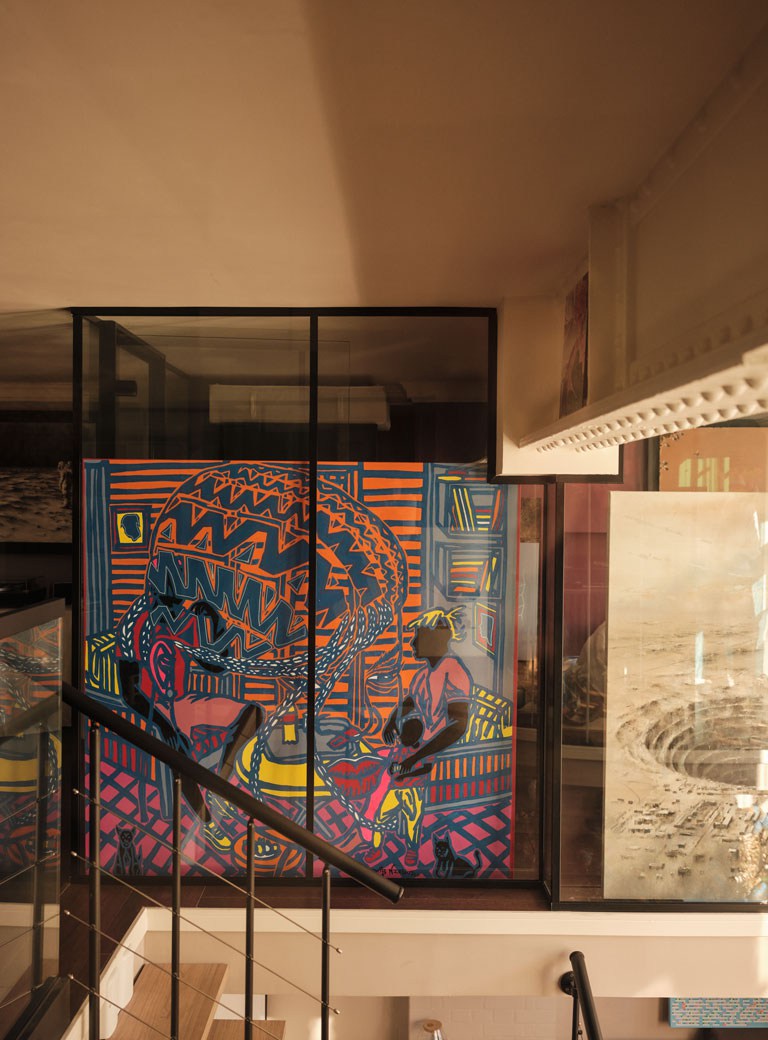
You both seem interested in social structures, was a wish to democratise entrenched systems around buying art in some ways what inspired Artscapy?
A: I think I have come to realise that what I want to achieve with Artscapy is honesty. It sounds inauthentic or perhaps clichéd to say so, but it’s about transparency and ethics and about giving people the tools, not only the software, but also the know-how to understand what art is. I think newcomers to art collecting can be easily exploited and I would like Artscapy to help them avoid any traps.
E: I think a big part for me was accessibility and helping people get into the world of art, right? It can be an intimidating journey. There are still times today when we walk into a gallery, and they look you up and down. It’s crazy that you have this kind of dynamic. It removes you so far from the art and from the idea of supporting cultural production, which for me is one of the most important things about collecting – supporting artists and supporting cultural production. So that’s how we wanted to make a difference. Transparency is the second step, Artscapy is not a marketplace, it’s a full suite that helps you handle an art portfolio or collection from end to end. It was a reaction to the frustration we felt at not having an easy way to manage our portfolio. We wanted one place where you could get your art valued, insured and source all the other things you need to be able to start, manage and continue to build a collection. And we wanted to make it digitally convenient for people wherever they are in the world.
What are the biggest things you have learnt on your journey as collectors and what tips would you give to people just starting?
A: Don’t collect just because you want to make money. That’s a vacuous approach. It helps to have someone impartial who can ask you about your objectives and help you to realise them. While Emilia and I have a formula for our collection, you can take a lighter approach too. But it helps to have someone or something that helps you navigate the dynamic of the market.
E: I think to me the most important thing is to have endless curiosity and to do your research. Don’t always fall for the first impression. What makes something valuable, in my opinion, is not something that you ‘get’ from the very beginning. Great quality art is difficult. It gradually impacts on you. I think the great artists are the ones who say and do something remarkable first and quite differently from anyone else. But you only find that through curiosity and through research. If something speaks to you take time to understand why and what is it that you like about it. Find out if other people have done something similar or how a topic has been tackled before. Understanding the dynamics of the art market and learning more about the artist and his or her practice, also helps. I would say those are the two things I really took away from the last few years of our activity as collectors.
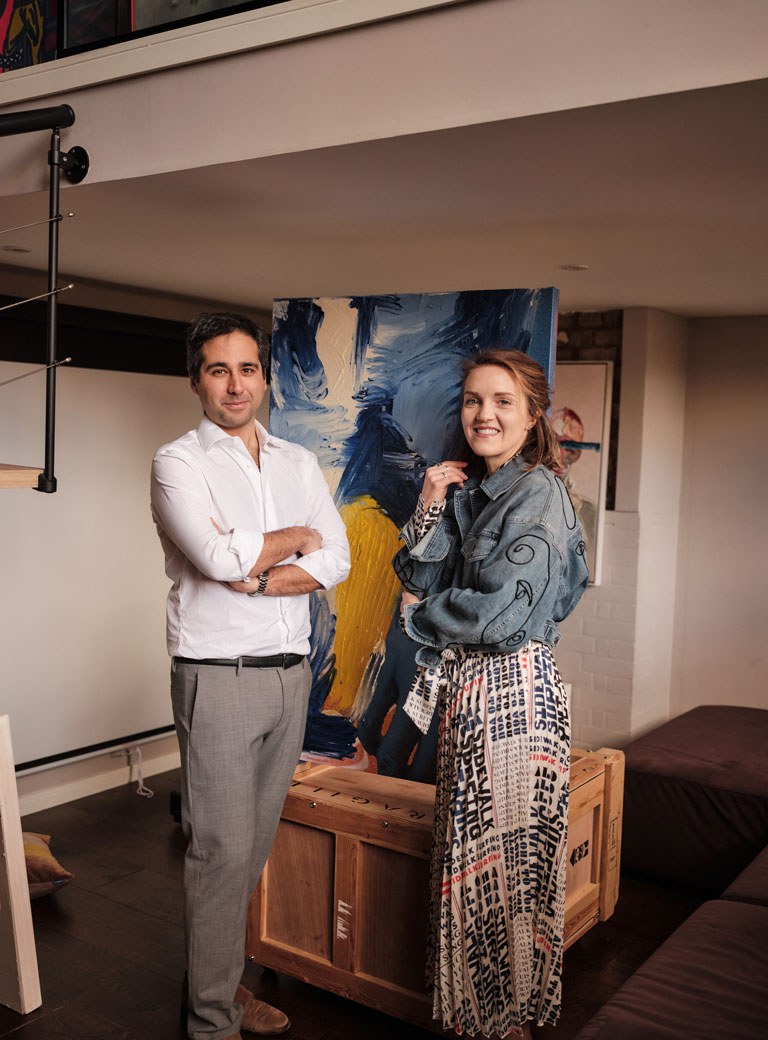
Interview: Frederica Miller
Photos: Liz Seabrook
Links:


